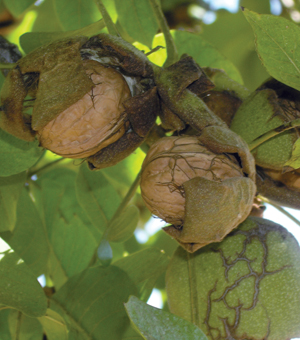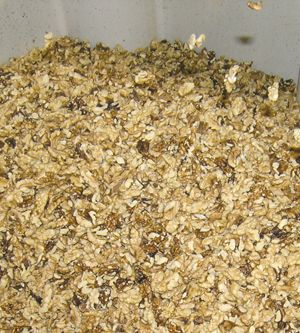
In a Nutshell
November 13, 2008
By
Brian Hartz
The next time you’re experimenting with ingredients, you might want to take another look at walnuts. They’ve long been associated with desserts and sweets – brownies, anyone? – but new research reveals that not only is the walnut tops among healthful nuts, it is also one of the world’s most nutrient-dense whole foods and is well suited for inclusion in a diverse range of recipes.
The next time you’re experimenting with ingredients, you might want to take another look at walnuts. They’ve long been associated with desserts and sweets – brownies, anyone? – but new research reveals that not only is the walnut tops among healthful nuts, it is also one of the world’s most nutrient-dense whole foods and is well suited for inclusion in a diverse range of recipes.
Rich in alphalinolenic acid (ALA), an essential omega-3 fatty acid, walnuts are a key part of the Mediterranean diet that can reduce the risk of heart attack and cardiovascular disease by up to 50 per cent, in addition to lowering LDL or “bad” cholesterol and decreasing the likelihood of developing diabetes. Walnuts also offer benefits in the areas of bone health and weight management.
Growing and harvesting walnuts
But where do walnuts come from and how do they get to bakers in Canada? That’s what the California Walnut Commission of Canada, based in Mississauga, Ont., wanted to illustrate in late September when it took food industry journalists on a walnut harvest tour in northern California, near Sacramento, the state capital.
With a mild climate and deep, fertile, well-drained soils providing ideal growing conditions, California produces 99 per cent of the commercial U.S. walnut supply and 66 per cent of the global supply; 98 per cent of the walnuts sold in Canada are grown in California, which in 2005-06 exported more than 15.7 million pounds of walnuts north of the border. The 2008 California walnut crop is estimated at 375,000 tons, representing a 57 per cent increase in production since 2000. Without a doubt, the state known for Hollywood and the Governator is the undisputed king of walnuts.
But that kingdom – comprising more than 200,000 acres of farmland worked by 4,000 growers – is built on the hard work of multi-generational family farms, as we discovered during the tour, which began at the orchards of Norene Ranches Inc. near Rio Oso and Wheatland, north of Sacramento.
Donald Norene runs the 750-acre farm with his wife, Sandy, and son Davin. He expanded the operation after taking it over from his father, Roy, who in turn inherited it from his father, who began growing walnuts in the early 1920s.
“From the time I was 10, I worked on the farm,” says Norene, who studied agricultural science and management at the University of California, Davis, graduating in 1973.
Norene grew peaches for a few years, but in 1994 he replaced his peach trees with more walnut acreage. Now the orchards produce between 1,200 and 1,500 tons – or 2.4 to 3 million pounds – of walnuts per year.
“We’re looking for three tons to the acre – that’s our yield objective,” he says. But recent harvests have been well above that figure, which, according to Norene, is due to a little bit of luck and a whole lot of investment in cutting-edge harvesting technology.
 |
|
| Californa Walnut Brownies | |
 |
|
| Ripe walnuts on the tree | |
 |
|
| Walnuts in a bin after they’ve been removed from their shells at a shelling facility.
|
During the September-November harvest season, Norene deploys a fleet of approximately Zamboni-sized machines to collect walnuts. First up is the shaker, which grips the trunk of a tree and, well, does just what you’d imagine. As we looked on during a demonstration, the ground beneath our feet also shook.
“The shaking is not a nice massage; it’s kind of a violent act,” Norene says. “But in the past 20 years there have been huge improvements. It’s still a violent shaking, but there’s been improvements such as built-in slippage that prevents the bark of the tree from being stripped off.”
When the dust had settled after only a minute or so of shaking, walnuts blanketed the ground around the tree. The shaker is remarkably efficient – and it has to be, with 80 trees per acre and 750 acres to harvest. And walnut trees can grow up to 100 feet tall, with each tree capable of producing thousands of nuts.
“Some of these trees will be shaken 45 times in 30 years. As they get older and more productive, we might end up shaking them twice in one season,” Norene says. “But with young trees, we don’t want to shake them when they’re real green and succulent, because the bark chips so easily.”
After the shaker comes the sweeper, which gathers the walnuts up into neat rows for the next machine, a sifter that picks up the walnuts and sorts out debris before depositing the nuts in a huge wheeled bin hitched to the back of this third machine.
“Using this equipment to pick them up in a proper manner helps us deliver a fresher, better quality product,” Norene says. “We try to have the orchard properly irrigated and time the harvest for optimal kernel quality. It seems to be working as people are buying more walnuts than ever – and the health benefits don’t hurt, either. Our business is really booming right now. It’s a heckuva lot better than the housing market.”
Indeed, with 2008 delivering dry weather perfectly suited to walnut growing, the current crop looks set to be about 16 per cent larger than last year’s, he says.
|
Nutritional analysis of walnuts
(1.5-ounce serving) |
||
| Calories | 278 |
|
| Protein | 6.5 g | |
| Total fat |
27.7 g | |
| Polyunsaturated fat | 20.1 g | |
| Monounsaturated fat |
3.8 g | |
| Saturated fat | 2.6 g |
|
| Trans fat |
0 g | |
| Dietary fibre |
2.8 g | |
| Sodium |
1 mg | |
| Potassium |
188 mg | |
| Cholesterol |
0 mg |
|
| Omega-3 fatty acid |
3.9 g | |
| Omega-6 fatty acid |
16.2 g | |
From tree to treats
But harvesting the walnuts is only part of the process. They have to be removed from their green outer hulls and then dried out and shelled. Some walnuts are left in their shells to serve the in-shell nut market – popular around the holidays, of course – but the vast majority are shelled. This is done at facilities such as Carriere Family Farms in Glenn, Calif., northwest of Norene Ranches Inc., run by Bill Carriere, a fifth-generation walnut farmer, and four of his cousins.
In addition to operating two hulling and drying centres, an in-shell packing plant and shelling plant, Carriere grows walnuts on 1,500 acres of land. Remarkably, Carriere’s processing facilities are operational for only about two months every year, during harvest season.
But those two months require an enormous amount of energy. During our tour, Carriere said he’s had solar panels installed on the roof of the hulling and drying facility because of its huge electricity consumption. “We’re hoping to generate up to 90 per cent of our own electricity requirement,” he says.
The hulling machinery was quiet on the day we visited, but the drying room – picture a huge sauna the size of a hockey rink – was going full-bore and greeted us with a blast of hot, dry air as we walked along a platform between its two enormous vats of walnuts. These are divided into bins with labels specifying to which client they belong, because the nuts are still considered an agricultural product and the property of the grower. Eventually, after charging a processing fee, Carriere will buy the nuts from the grower; at this point they are considered a commercial product and are taken to the shelling plant where they’re shelled, sorted and packaged for shipping to markets around the world. Coincidentally, our tour of the shelling plant ended at a group of pallets stacked high with boxes of walnuts about to be exported to Canada.
Walnuts part of menu makeovers
Before sending us back to Canada, the California Walnut Commission gathered some U.S. food and nutrition luminaries for a presentation on the Smart Menu campaign, which aims to make popular holiday and everyday recipes more nutritious by using walnuts and other healthful ingredients. TV doctor Michael Roizen – known for the RealAge and YOU health improvement books, the latter written in collaboration with Dr. Mehmet Oz – teamed up with Moosewood Cookbook author Mollie Katzen for a holiday cooking demonstration at Mulvaney’s B&L, a gourmet restaurant in Sacramento. Its owner, acclaimed chef Patrick Mulvaney, joined Roizen and Katzen on stage for the demo after introductions by walnut commission CEO Dennis Balint and California Secretary of Agriculture A.G. Kawamura.
“You can change the way your body works, and the way you feel, with the food you eat,” says Roizen, citing research by Progressive Grocer showing that in 2007 U.S. consumers spent more than $69 billion on candy, snacks, soft drinks and bottled water compared to just under $67 billion on fresh produce. Katzen adds that their goal is “to find the most appealing and delicious ways to prepare and present fruits, vegetables, whole grains, good oils, legumes, nuts and meat and dairy – and to get people eating smart and feeling and looking wonderful.”
The pair’s first targets are the celebratory and comfort foods, including baked goods, in which people are prone to overindulge during the holiday season, but their ultimate goal is to make over a total of 50 popular recipes, one season at a time. So far, they have reinvented dishes such as turkey with stuffing and gravy, winter meatloaf, pasta, soups and stews to be up to 33 per cent lower in fat and calories.
For more information about California walnuts, including recipes and nutritional data, see www.walnutinfo.com .
Print this page
Leave a Reply